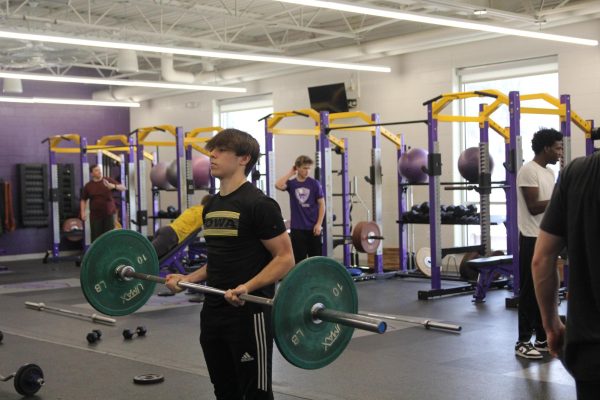Piling on the stress
Along with the pressures of a busy schedule comes the downward spiral of stress and anxiety
editor’s note: *We have withheld the name of a student to protect her privacy and minimize harm. We will refer to that student as Student A. Student A has a diagnosed anxiety disorder.
A downward spiral of nervousness and tensions that blocks out the world, anxiety can overwhelm a person at any age, any time and any place.
About one in four teens suffer from anxiety or an anxiety disorder, such as post-traumatic stress disorder or obsessive compulsive disorder.
“I cannot hear what anyone is saying to me. I can’t focus on anything except for what’s happening right now, which is ‘I’m not safe,’ or ‘I don’t know what’s going on, and I need to get out,’” Student A* said. “I will use deep breathing techniques or listen to music. If I’m anxious in class I will squeeze on Play-Doh or putty.”
Emotional support animals can be another coping strategy. Student A has two sugar gliders whose sweetness calms her.
School and schoolwork are a primary factor in students’ stress level. When their schedules pile up, the stress and anxiety kicks in. Although not taught in school, the ability to self-manage and prioritize may be the factors that keep stress in check and anxiety away.
COMMITMENTS
Emma Holt (10) attends volleyball practice every day from 3:45 to 6:00 p.m.
After volleyball practice she stays up until 11:00 p.m. tackling homework. Holt gets around six to seven hours of sleep on school nights.
(A typical teenager needs approximately nine hours. When students like Holt only get around seven hours asleep, by the end of the school week they have lost the equivalent of one night’s worth of rest.)
On Tuesdays and Thursdays, she goes to Wildwood Crossfit and attends her class.
Outside of school, Holt participates in StuCo meetings and activities like volunteering at the retirement home and bringing in cans for the canned food drive.
Holt also makes time to connect with her mom and dad and three sisters whether it be eating dinner all together or eating Silky’s on Bachelorette Monday.
“I am never able to get a family dinner together without at least one daughter missing because they are all doing so much,” Mrs. Becky Holt, mother of Emma, said. “Driving them around non-stop can be a drag, as well.”
Students like Emma Holt struggle with overcommitting. Overcommitting happens when students’ planners fill up and they struggle to balance all aspects of their lives.
“I realized I was starting to overcommit when all of a sudden it was so hard to do everything all the time,” Bridge Sisco (10) said. “I noticed things like all of my homework wasn’t being completed or I wasn’t getting any sleep.”
Not only are kids overwhelmed by this busyness, parents are, too.
“There is never enough time in the day,” Mrs. Barb Crowder, EHS mother of two, said. “Figuring out how to balance it all can be tough because it always seems like homework is in last place.”
The helix of their childrens’ lives, parents are the foundation of support.
“I offer unconditional support and guidance so my kids can learn to be independent and responsible students,” Mrs. Darla Baker, EHS mother of two, said. “They are going to mess up or be stressed out; it’s part of being a kid.”
MOTIVES
“I’ve always believed the more you’re involved in, the better the college resume,” Grace Archambault (12) said.
Post-high school plans are often behind the push to participate and commit.
“I participate in StuCo because I’ve been told colleges like to see students getting involved in school activities,” Emma Holt said. “That was one of the main reasons I decided to join.”
The idea that colleges look for super-involved students may be misleading.
“Best thing for a student to do is to do what they love and go deep in one or two things versus trying to go wide in 10 things,” Mr. Jeff Buckman, career and college counselor, said in an email interview conducted, Nov. 17. “It’s always about depth more than width. Colleges give the same weight to athletics, service, a job, etc.”
An empty planner can be just as overwhelming as a packed one. Sometimes involvement can keep a student on track.
“I like always having something to do,” Natalie Barth (10) said. “It keeps me from procrastinating or finding myself bored all the time.”
Keeping busy can help keep one focused. However, being involved in multiple activities to get into college is not always the most effective approach.
“Kids try to get involved in too many things to have a great college resume,” Mr. Brad Klages, junior class principal, said. “Too many kids have this ‘I want to go to this school’ when I get done with high school. So they feel like they have to take all these AP classes and do all these sports when really it’s not like that.”
The point should of all this involvement should be for students to find their passion. Once discovered, that passion should be the primary focus and motivation, Mr. Klages said.
ASSESSING
EHS provides so many opportunities for students to participate in fall, spring and winter sports and school sponsored clubs. It’s easy for students to be involved in multiple activities or sports at once.
Historically a two-season athlete, Archambault learned she had to make some hard choices.
“I play volleyball and basketball,” Archambault said. “Playing two sports on top of school was very time consuming, so I eventually decided to quit volleyball. Once I did it was a lot more relieving knowing that I had the free time now for homework and other important stuff.”
The older students get, the more frequently they have to choose which interest to pursue further.
“It is very important that young people today be aware of their priorities,” Dr. Maxine Gilner, marriage and family therapist, said. “If you are coming up with more demands in a day than hours and you are not getting sleep or any kind of relaxation, then you don’t have to be a genius to know that you are going to have a problem.”
Experts emphasize a level of personal awareness that isn’t necessarily taught anywhere.
“I only advise students when their grades are below the expectations,” Dr. Jennifer Stith, Professor of Physical Therapy and Neurology at Washington University School of Medicine, said in a phone interview conducted, Nov. 4. “If they are starting to struggle, I help them figure out how much more they should be committing to school verses other things.”
Personal awareness is not a class taught at school. Mr. Charles Crouther, head principal, believes students have those resources already in place.
“I do not think it is a greater challenge for kids to find balance,” Mr. Crouther said. “The students in my opinion are more involved now, but they have a support group at home and with friends, coaches and teachers that help them balance it out and schedule the activities so they can get it all in.”
TOOLS
A lack of downtime can be a major factor in rising stress levels.
“I put a lot of time into school plus I play two sports, soccer and lacrosse,” Josh Stolz (10) said. “It’s rare if I have time to actually sit down and do something I actually love like watching my favorite movie ‘Top gun.’”
Downtime is a time for students to recover from all of their commitments, but if downtime isn’t there, the recovery isn’t there and stress will continue to build.
“It is good to be busy because that helps you not procrastinate, but here is the balance part,” Ms. Jessica Williams, Talented and Gifted program counselor, said. “You have got to have time for yourself.”
Not finding time for one’s boundaries can lead to greater consequences for mental health.
“It’s the effect of not having the downtime that all students need, whether it’s to sleep or rest or to not worry about everything,” Mrs. Jennifer Strauser, associate principal, said. “I think it has something to do with the anxiety the students have.”
Overcommitment and anxiety go hand-in-hand.
“When my plate starts to get too full and my schedule is super busy, I notice that I get a lot more stressed out and panicked,” Grace Eickel (11) said. “A little bit of anxiety starts to kick in. I get super anxious and overwhelmed. I feel like everything is crumbling and piling up on top of me. There is a ton of weight on my shoulders.”
When struggling with the issue of overcommitting, deciding which commitments are most important and cutting the rest is vital. Quitting may be just the step needed for the sake of students’ mental health.
“It is important to put yourself first. If your personal well-being is compromised, then quitting or scaling back is the right decision.” Ms. Williams said. “It’s not giving up. We are making new choices and moving forward.”
To help with the stress in students’ lives, EHS will hold a student health and wellness conference, Nov. 21.
9:46-9:50ish a.m.: Students report to 1st hour for attendance.
- backpacks, etc. stay in classrooms.
- Classes will be dismissed to Gym A by intercom.
9:50-11:25ish a.m.: The Awakening Project
11:25-11:40 a.m.: Students return to 1st hour to pick up belongings.
- Classes will be dismissed to fourth hour by regular late-start bell.
- Teachers pass out breakout slips to the students in their fourth hour classes.
11:46 a.m-1:06 p.m.: Fourth hour classes and lunch as normal.
- Students must turn in the slip when entering their sessions.
- Teachers give any students without a slip a late sign-up sheet; the students fill it out.
1:11-2:25 p.m.: Breakout sessions
2:31-3:05 p.m.: Students attend their seventh hour classes for reflection activity.
“It’s really interesting how us teachers and administrative put so much work and time in for the kids but then we never involve the kids,” Mrs. Strauser said. “by having this conference we hope the students build a toolbox of coping skills to deal with their stress.”
The entire student body will learn together how to cope with the stress of academics, social media, extracurricular activities and any issues teenagers might face by choosing and attending small classes with teachers.
Emma Holt will be attending yoga and mindfulness and looks forward to learning new ways to help avoid the downward spiral of stress and anxiety.
Your donation will support the student journalists of Eureka High School - MO. Your contribution will allow us to purchase equipment and cover our annual website hosting costs.

This is Hannah’s third semester on the EHS hub staff. She writes her own opinions column and is a news reporter.
You can follow her on Twitter @hmellorEHS_hub....

@mperezEHS_hub
This is Perez's third year on staff where she serves as a reporter for the Hub. One word to describe her: independent. Perez is involved...






















Susie Duggan • Nov 22, 2016 at 10:09 PM
Great article, Hannah. Controlling stress will be a lifelong challenge. Everyone deals with stress differently so you must find a method that works for you. Asking for help is very important.
I hope your article has helped some of your classmates.